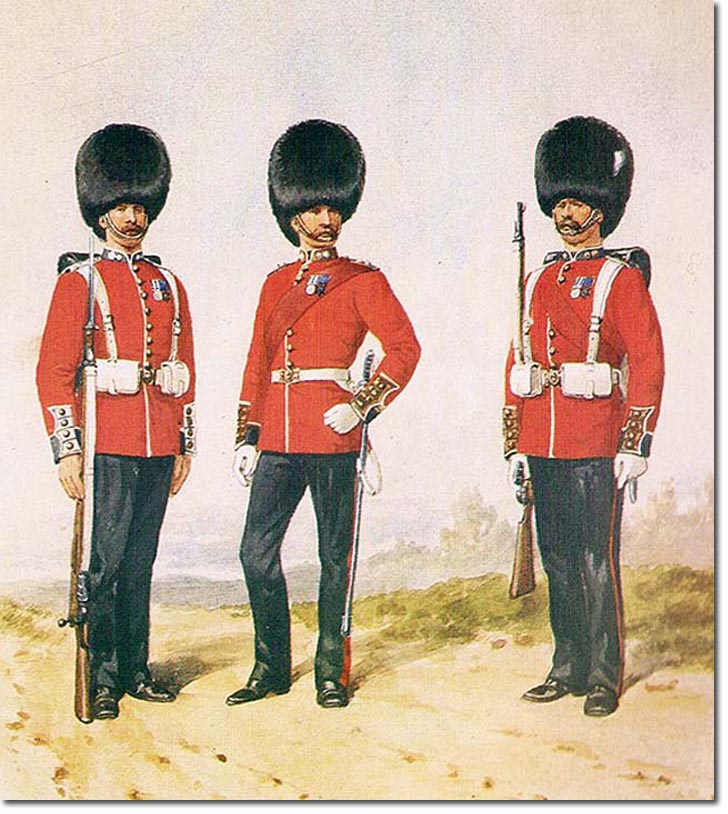|
|

 |
|
Simkin's Military Types were published in the Army and Navy Gazette over a period of 9 years from Jan 1888 to Apr 1897. This accurate watercolour painting was the basis of print no.35 Grenadier Guards published on 1 Nov 1890. The officer stands in the middle with the private on the left and sergeant on the right. They are all in review order (with valises) and displaying medals for service in Egypt in 1882. Both the 1st and 3rd Battalions served in Egypt and/or the Sudan in the 1880s but the men depicted are 1st Battalion because they were in London in 1890 and would have been the first to be issued with the Slade Wallace valise equipment.
On the left is the private (not called guardsman at this stage) in review order wearing a scarlet tunic with evenly spaced buttons. The Guards regiments were distinguished from the line regiments by the slashed cuff. Infantry regiments of the line had round cuffs without the slash flap. He wears equipment which is polished and whitened for parades, involving much work. The pouches, valise and straps were designed by Colonels Slade and Wallace and accepted by the army in 1888 to replace the valise equipment of 1882. The pouches on the front of the belt each held 50 rounds of ammunition when on campaign. Today's guardsmen are fortunate in not having to carry this equipment while performing their ceremonial duties. The rifle, with fixed bayonet, he is holding is the Lee Metford .303 introduced c1890. The sergeant is holding his rifle at his side by the trigger guard. This rifle was not carried at the slope. His bearskin (NOT busby) has a white horsehair plume on the left side. All ranks of the Grenadier Guards have this distinction. In the days when each regiment had an elite Grenadier Company, they were distinguished by the plain white plume, while the Light Company had a green plume and the rest of the regiment had red and white. The sergeant has no visible sign of his rank as the gold lace chevrons are on his upper right arm. But he does have a red sash of office on his right shoulder, worn under his equipment. He is also wearing a sergeant's quality tunic with gold wire embroidered collar badge, instead of white, and gold lace on his cuffs and rear skirts of his tunic. The sergeant wears the same equipment as the private but certain ranks were exempt from having to carry this burden, from 1886, including the RSM and other Warrant Officers, Drill Sergeants, Colour Sergeants etc. The officer is a captain, having two stars on each shoulder strap. In 1881 the badges of rank ceased to be worn on the collar and were moved to the shoulders. Officers wore their crimson silk sash on the left shoulder. His tunic is embellished with gold lace and embroidery and silver wire embroidered grenade collar badges. The blue trousers have a scarlet stripe down the sides 1.5 inches wide. The Commanding Officer, the second in command and the adjutant wore breeches and knee boots. At levees the trousers with gold stripes were worn. The bearskins of all three men are of similar size and shape. The 1891 Dress Regulations for officers stipulated 8 inches high but in 1900 there were differing heights according to the height of the officer. The lowest bearskin was 8.5 inches for a man 5ft 6ins tall. The highest was 10 inches for a man over 6 foot. The upright plume on the left side was of goats hair, 6 inches long. |
Armed Forces | Art and Culture | Articles | Biographies | Colonies | Discussion | Glossary | Home | Library | Links | Map Room | Sources and Media | Science and Technology | Search | Student Zone | Timelines | TV & Film | Wargames